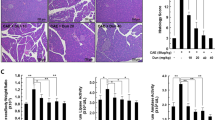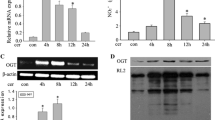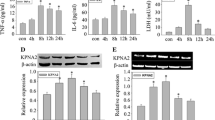Abstract
Objective
NADPH oxidase is potentially associated with acute pancreatitis by producing reactive oxygen species (ROS). We investigated whether NADPH oxidase mediates the activation of Janus kinase (Jak)2/signal transducers and activators of transcription (Stat)3 and mitogen-activated protein kinases (MAPKs) to induce the expression of transforming growth factor-β1 (TGF-β1) in cerulein-stimulated pancreatic acinar cells.
Treatment
AR42J cells were treated with an NADPH oxidase inhibitor diphenyleneiodonium (DPI) or a Jak2 inhibitor AG490. Other cells were transfected with antisense or sense oligonucleotides (AS or S ODNs) for NADPH oxidase subunit p22phox or p47phox.
Methods
TGF-β1 was determined by enzyme-linked immonosorbent assay. STAT3-DNA binding activity was measured by electrophoretic mobility shift assay. Levels of MAPKs as well as total and phospho-specific forms of Jak1/Stat3 were assessed by Western blot analysis.
Results
Cerulein induced increases in TGF-β1, Stat3-DNA binding activity and the activation of MAPKs in AR42J cells. AG490 suppressed these cerulein-induced changes, similar to inhibition by DPI. Cerulein-induced activation of Jak2/Stat3 and increases in MAPKs and TGF-β1 levels were inhibited in the cells transfected with AS ODN for p22phox and p47phox compared to S ODN controls.
Conclusion
Inhibition of NADPH oxidase may be beneficial for prevention and treatment of pancreatitis by suppressing Jak2/Stat3 and MAPKs and expression of TGF-β1 in pancreatic acinar cells.








Similar content being viewed by others
References
Schoenberg MH, Büchler M, Gaspar M, Stinner A, Younes M, Melzner I, Bültmann B, Beger HG. Oxygen free radicals in acute pancreatitis of the rat. Gut. 1990;31:1138–43.
Petrone WF, English DK, Wong K, McCord JM. Free radicals and inflammation: superoxide dependent activation of a neutrophil chemotactic factor in plasma. Proc Natl Acad Sci USA. 1980;77:1159–63.
Wisner J, Green DF, Renner I. Evidence for a role of oxygen derived free radicals in the pathogenesis of cerulein induced acute pancreatic in rat. Gut. 1988;29:1516–23.
Hofbauer B, Saluja AK, Lerch MM, Bhagat L, Bhatia M, Lee HS, Frossard JL, Adler G, Steer ML. Intra-acinar cell activation of trypsinogen during cerulein-induced pancreatitis in rat. Am J Physiol. 1998;275:G352–62.
Lerch MM, Adler G. Experimental animal model of acute pancreatitis. Int J Pancreatol. 1994;15:159–70.
Willemer S, Elasser HP, Alder G. Hormone-induced pancreatitis. Eur Surg Res. 1992;24(Suppl 1):29–39.
Willwmer S, Adler G. Mechanism of acute pancreatitis. Cellular and subcellular events. Int J Pancreatol. 1991;9:21–30.
Muller-Pillasch F, Menke A, Yamaguchi H, Elsasser HP, Bachem M, Adler G, Gress TM. TGF-beta and the extracellular matrix in pancreatitis. Hepatogastroenterology. 1999;46:2751–6.
Shek FW, Benyon RC, Walker FM, McCrudden PR, Pender SL, Williams EJ, Johnson PA, Johnson CD, Bateman AC, Fine DR, Iredale JP. Expression of transforming growth factor-beta 1 by pancreatic stellate cells and its implications for matrix secretion and turnover in chronic pancreatitis. Am J Pathol. 2002;160:1787–98.
Ottaviano AJ, Sun L, Ananthanrayanan V, Munshi HG. Extracellular matrix-mediated membrane-type 1 matrix metalloproteinase expression in pancreatic ductal cells is regulated by transforming growth factor-beta1. Cancer Res. 2006;66:7032–40.
Yoshikawa H, Kihara Y, Taguchi M, Yamaguchi T, Nakamura H, Otsuki M. Role of TGF-beta1 in the development of pancreatic fibrosis in Otsuka Long-Evans Tokushima Fatty rats. Am J Physiol Gastrointest Liver Physiol. 2002;282:G549–58.
Lugea A, Nan L, French SW, Bezerra JA, Gukovskaya AS, Pandol SJ. Pancreas recovery following cerulein-induced pancreatitis is impaired in plasminogen-deficient mice. Gastroenterology. 2006;131:885–99.
Nagashio Y, Ueno H, Imamura M, Asaumi H, Watanabe S, Yamaguchi T, Taguchi M, Tashiro M, Otsuki M. Inhibition of transforming growth factor beta decreases pancreatic fibrosis and protects the pancreas against chronic injury in mice. Lab Invest. 2004;84:1610–8.
Bjork J, Arfors KE. Oxygen free radicals and leukotriene B4 induced increase in vascular leakage is mediated by polymorphonuclear leukocytes. Agents Actions Suppl. 1982;11:63–72.
Guice KS, Oldham KT, Caty MG, Johnson KJ, Ward PA. Neutrophil-dependent, oxygen-radical mediated lung injury associated with acute pancreatitis. Ann Surg. 1989;210:740–7.
Yu JH, Lim JW, Namkung W, Kim H, Kim KH. Suppression of cerulein-induced cytokine expression by antioxidants in pancreatic acinar cells. Lab Invest. 2002;82:1359–68.
Ju KD, Yu JH, Kim H, Kim KH. Role of mitogen-activated protein kinases, NF-κB, and AP-1 on cerulein-induced IL-8 expression in pancreatic aincar cells. Ann NY Acad Sci. 2006;1090:368–74.
Babu BI, Malleo G, Genovese T, Mazzon E, Di Paola R, Crisafulli C, Caminiti R, Siriwardena AK, Cuzzocrea S. Green tea polyphenols ameliorate pancreatic injury in cerulein-induced murine acute pancreatitis. Pancreas. 2009;38(8):954–67.
Koh YH, Tamizhselvi R, Bhatia M. Extracellular signal-regulated kinase 1/2 and c-Jun NH2-terminal kinase, through nuclear factor-kappaB and activator protein-1, contribute to cerulein-induced expression of substance P and neurokinin-1 receptors in pancreatic acinar cells. J Pharmacol Exp Ther. 2010;332(3):940–8.
Hiraoka W, Vazquez N, Nieves-Neira W, Nieves-Neira W, Chanock SJ, Pommier Y. Role of oxygen radicals generated by NADPH oxidase in apoptosis induced in human leukemia cells. J Clin Invest. 1998;102:1961–8.
Arroyo A, Modrianský M, Serinkan FB, Bello RI, Matsura T, Jiang J, Tyurin VA, Tyurina YY, Fadeel B, Kagan VE. NADPH oxidase-dependent oxidation and externalization of phosphatidylserine during apoptosis in Me2SO-differentiated HL-60 cells. Role in phagocytic clearance. J Biol Chem. 2002;277:49965–75.
Griendling KK, Sorescu D, Ushio-Fukai M. NAD(P)H oxidase: role in cardiovascular biology and disease. Circ Res. 2000;86:494–501.
Yu JH, Lim JW, Kim H, Kim KH. NADPH oxidase mediates interukin-6 expression in cerulein-stimulated pancreatic acinar cells. Int J Biochem Cell Biol. 2005;37:1458–69.
Sarmiento N, Sánchez-Bernal C, Ayra M, Pérez N, Hernández-Hernández A, Calvo JJ, Sánchez-Yagüe J. Changes in the expression and dynamics of SHP-1 and SHP-2 during cerulein-induced acute pancreatitis in rats. Biochim Biophys Acta. 2008;1782(4):271–9.
Sarmiento N, Sánchez-Bernal C, Pérez N, Sardina JL, Mangas A, Calvo JJ, Sánchez-Yagüe J. Rolipram and SP600125 suppress the early increase in PTP1B expression during cerulein-induced pancreatitis in rats. Pancreas. 2010;39(5):639–45.
Samuel I, Zaheer A, Fisher RA. In vitro evidence for role of ERK, p38, and JNK in exocrine pancreatic cytokine production. J Gastrointest Surg. 2006;10(10):1376–83.
Liu KD, Gaffen SL, Goldsmith MA. JAK/STAT signaling by cytokine receptors. Curr Opin Immunol. 1998;10:271–8.
Darnell JE, Kerr IM, Stark GR. Jak-STAT pathways and transcriptional activation in response to IFNs and other extracellular signaling proteins. Science. 1994;264:1415–21.
Carballo M, Conde M, El Bekay R, Martín-Nieto J, Camacho MJ, Monteseirín J, Conde J, Bedoya FJ, Sobrino F. Oxidative stress triggers STAT3 tyrosine phosphorylation and nuclear translocation in human lymphocytes. J Biol Chem. 1999;274:17580–6.
Gallmeier E, Schäfer C, Moubarak P, Tietz A, Plössl I, Huss R, Göke B, Wagner AC. JAK and STAT proteins are expressed and activated by IFN-gamma in rat pancreatic acinar cells. J Cell Physiol. 2005;203(1):209–16.
Ferrand A, Kowaski-Chauvel A, Bertrand C, Escrieut C, Mathieu A, Portolan G, Pradayrol L, Fourmy D, Dufresne M, Seva C. A novel mechanism for Jak2 activation by a G protein-coupled receptor, the CCK2R. J Biol Chem. 2005;280:10710–5.
Yu JH, Kim KH, Kim H. Suppression of IL-1β expression by the Jak2 inhibitor AG490 in cerulein-stimulated pancreatic acinar cells. Biochem Pharmacol. 2006;72:1555–62.
Meydan N, Grunberger T, Dadi H, Shahar M, Arpaia E, Lapidot Z, Leeder JS, Freedman M, Cohen A, Gazit A, Levitzki A, Roifman CM. Inhibition of acute lymphoblastic leukemia by a Jak2 inhibitor. Nature. 1996;379:645–8.
Nielsen M, Kaltoft K, Nordahl M, Röpke C, Geisler C, Mustelin T, Dobson P, Svejgaard A, Odum N. Constitutive activation of a slowly migrating isoform of Stat3 in mycosis fungoides: tyrphostin AG490 inhibits Stat3 activation and growth of mycosis fungoides tumor cell lines. Proc Natl Acad Sci USA. 1997;94:6764–9.
Burdelya L, Catlett-Falcone R, Levitzki A, Cheng F, Mora LB, Sotomayor E, Coppola D, Sun J, Sebti S, Dalton WS, Jove R, Yu H. Combination therapy with AG-490 and interleukin 12 achieves greater antitumor effects than either agent alone. Mol Cancer Ther. 2002;1:893–9.
Dignam JD, Lebovitz RM, Roeder RG. Accurate transcription initiation by RNA polymerase II in a soluble extract from isolated mammalian nuclei. Nucleic Acids Res. 1983;11:1475–89.
Tallarida RJ, Murray RB. Manual of pharmacological calculations with computer programs. New York: Springer; 1987. p. 121–5.
Rawlings JS, Rosler KM, Harrison DA. The JAK/STAT signaling pathway. J Cell Sci. 2004;117:1281–3.
Simon AR, Rai U, Fanburg BL, Cochran BH. Activation of the JAK-STAT pathway by reactive oxygen species. Am J Physiol. 1998;275:C1640–52.
Barrett WC, DeGnore JP, Konig S, Fales HM, Keng YF, Zhang ZY, Yim MB, Chock PB. Regulation of PTP1B via glutathionylation of the active site cysteine 215. Biochemistry. 1999;38:6699–705.
Jones RD, Hancock JT, Morice AH. NADPH oxidase: a universal oxygen sensor? Free Radic Biol Med. 2000;29:416–24.
Suzuki Y, Ono Y, Hirabayashi Y. Rapid and specific reactive oxygen species generation via NADPH oxidase activation during Fas-mediated apoptosis. FEBS Lett. 1998;425:209–12.
Wyatt CN, Weir EK, Peers C. Diphenyleneiodonium blocks K+ and Ca2+ currents in type I cells isolated from the neonatal rat carotid body. Neurosci Lett. 1994;172:63–6.
Weir EK, Wyatt CN, Reeve HL, Huang J, Archer SL, Peers C. Diphenyleneiodonium inhibits both potassium and calcium currents in isolated pulmonary artery smooth muscle cells. J Appl Physiol. 1994;76:2611–5.
Menon SG, Sarsour EH, Spitz DR, Higashikubo R, Sturm M, Zhang H, Goswami PC. Redox regulation of the G1 to S phase transition in the mouse embryo fibroblast cell cycle. Cancer Res. 2003;63:2109–17.
Scaife RM. G2 cell cycle arrest, down-regulation of cyclin B and induction of mitotic castrophe by the flavoprotein inhibitor diphenyleneiodonium. Mol Cancer Ther. 2004;3:1229–37.
Li N, Karin M. Is NF-κB the sensor of oxidative stress? FASEB J. 1999;13:1137–43.
Anderson MT, Staal FJ, Gitler C, Herzenberg LA, Herzenberg LA. Separation of oxidant-initiated and redox-regulated steps in the NF-κB signal transduction pathway. Proc Natl Acad Sci USA. 1994;91:11527–31.
Brennan P, O’Neill LA. Effects of oxidants and antioxidants on nuclear factor kappa B activation in three different cell lines: evidence against a universal hypothesis involving oxygen radicals. Biochim Biophys Acta. 1995;1260:167–75.
Samanta AK, Lin H, Kantarjian STH, Arlinghaus RB. Janus kinase 2: a critical target in chronic myelogenous leukemia. Cancer Res. 2006;66:6468–72.
Saxena NK, Sharma D, Ding X, Lin S, Marra F, Merlin D, Anania FA. Concomitant activation of the JAK/STAT, PI3 K/AKT, and ERK signaling is involved in leptin-mediated promotion of invasion and migration of hepatocellular carcinoma cells. Cancer Res. 2007;67:2497–507.
Li Y, Trush MA. Diphenyleneiodonium, an NAD(P)H oxidase inhibitor, also potently inhibits mitochondrial reactive oxygen species production. Biochem Biophys Res Comm. 1998;253:295–9.
Christophe J. Pancreatic tumoral cell line AR42J: an amphicrine model. Am J Physiol. 1994;266:G963–71.
Piiper A, Leser J, Lutz MP, Beil M, Zenzem S. Subcellular distribution and function of Rab3A-D in pancreatic acinar AR42J cells. Biochem Biophys Res Commun. 2001;287:746–51.
Sata N, Klonowski-Stumpe H, Han B, Luthen R, Haussinger D, Niederau C. Cytotoxicity of peroxynitrite in rat pancreatic acinar AR42J cells. Pancreas. 1997;15:278–84.
Masamune A, Sasaki Y, Satoh A, Fujita M, Yoshida M, Shimosegawa T. Lysophosphatidylcholine induces apoptosis in AR42J cells. Pancreas. 2001;22:75–83.
Acknowledgments
This study was supported by the Basic Science Research Program through the National Research Foundation of Korea (NRF) funded by the Ministry of Education, Science and Technology (2010-0001669) and a grant (Joint Research Project under the Korea-Japan Basic Scientific Cooperation Program) from NRF (F01-2009-000-10101-0). H. Kim is grateful to Brain Korea 21 Project, College of Human Ecology, Yonsei University.
Author information
Authors and Affiliations
Corresponding author
Additional information
Responsible Editor: Liwu Li.
Rights and permissions
About this article
Cite this article
Ju, K.D., Lim, J.W., Kim, K.H. et al. Potential role of NADPH oxidase-mediated activation of Jak2/Stat3 and mitogen-activated protein kinases and expression of TGF-β1 in the pathophysiology of acute pancreatitis. Inflamm. Res. 60, 791–800 (2011). https://doi.org/10.1007/s00011-011-0335-4
Received:
Revised:
Accepted:
Published:
Issue Date:
DOI: https://doi.org/10.1007/s00011-011-0335-4




